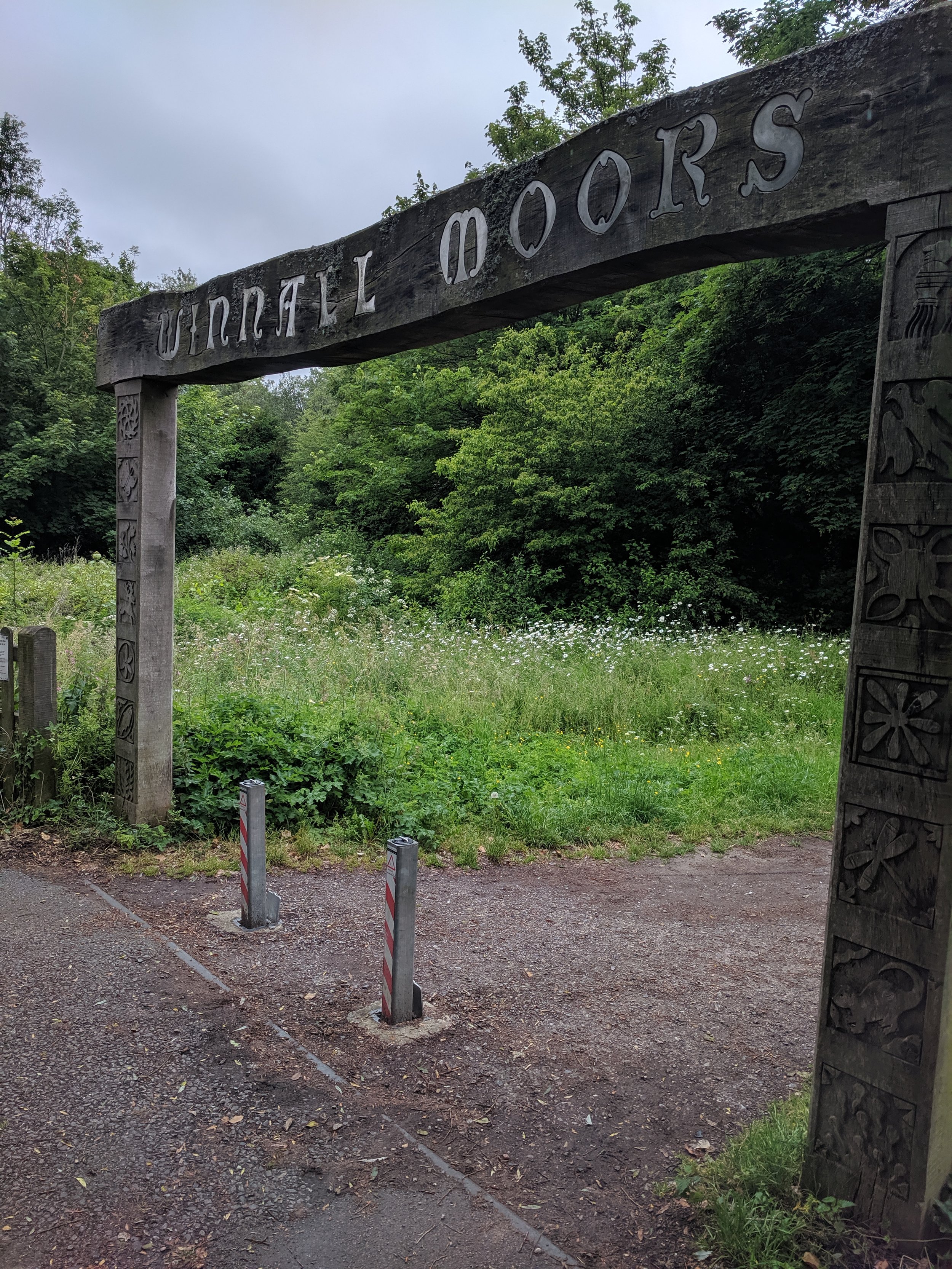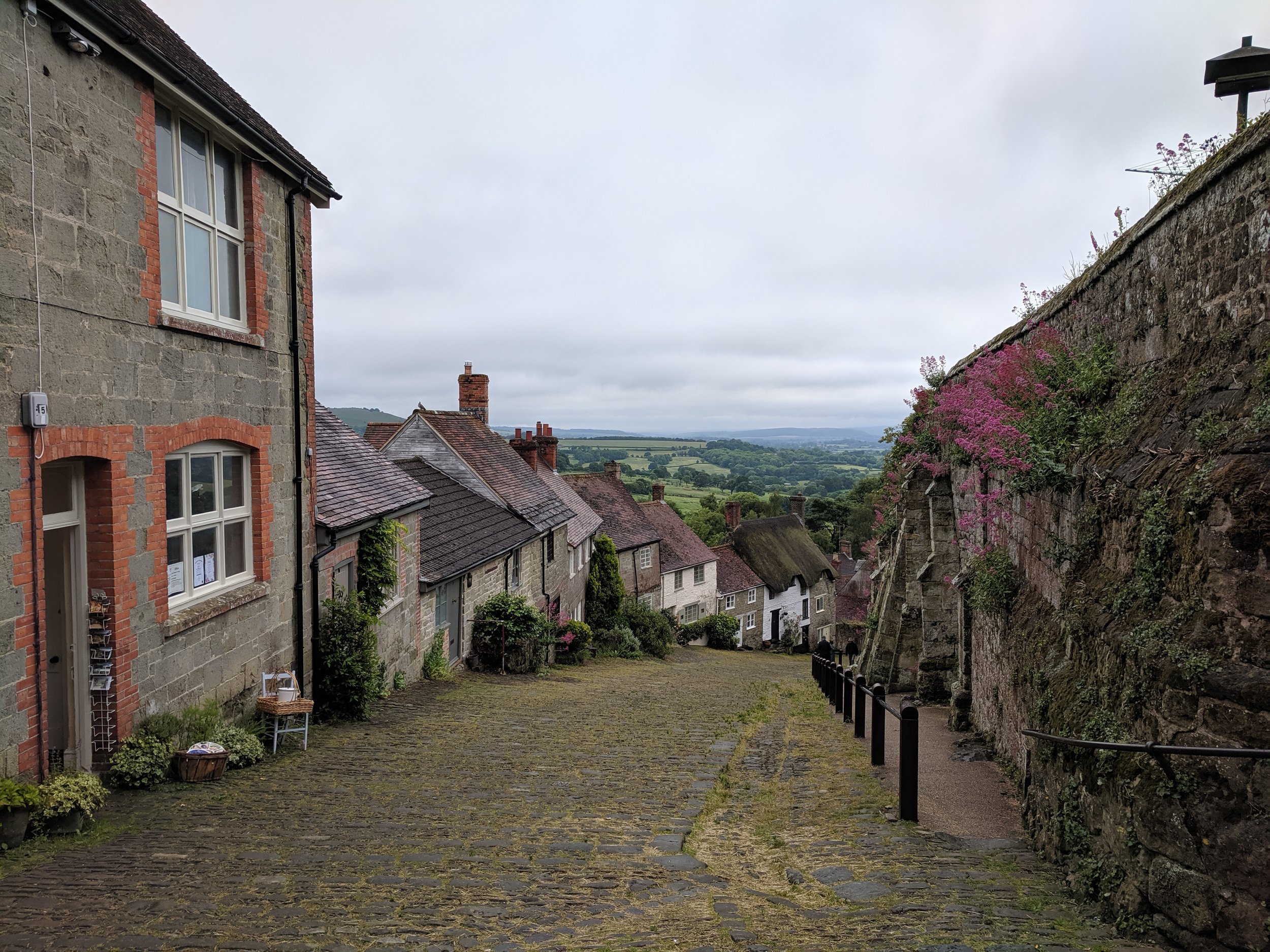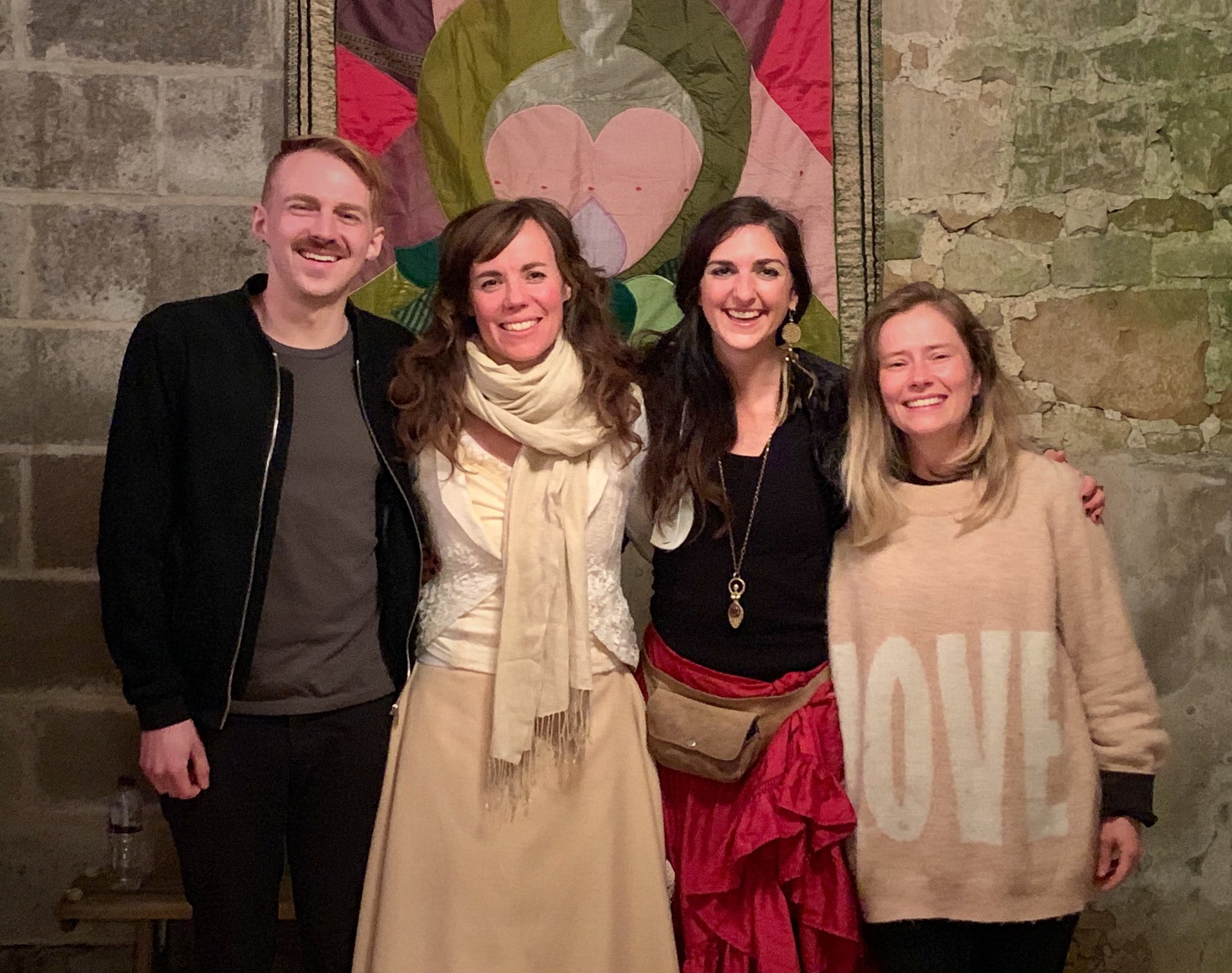On the double-decker bus from my friend Jack’s house to the train station, I sat at the very front on the second floor — or is it the first floor, and you enter on the ground floor? Either way, I watched out the huge front window as we appeared to narrowly avoid colliding with all of London.
Vegan pie and mash and mushy peas!
A hop, skip, and a jump later, I was in Winchester! Reunited with my dear friend Rex, who very graciously played host, tour guide, and roadie for the next few days. We went to a pie-and-mash-and-comic-book shop called Piecaramba!, and I had a delicious vegan pie and mash, and my very first mushy peas. (Which I loved. So minty! So mushy!)
We returned to Winnall Moors, a wonderful place Rex showed me during my first stay in Winchester in December 2017. The entrance recalls to me a Shinto Shrine’s torii gate, which “symbolically marks the transition from the mundane to the sacred” (Wikipedia). The top beam of the gateway is carved with Winnall Moors as you enter and Winchester as you exit, suggesting that the moors, though located within Winchester, are somehow apart from Winchester. A Narnia type arrangement, maybe.
In a tree where, on my last visit, someone had told me to look for a Common Buzzard (Buteo buteo), I again found no buzzard, in spite of it being the perfect place for one. In lieu of a buzzard were two Common Wood-pigeons. This was truly the tour of Wood-pigeons — I don’t know if it’s always like this in June, but there were just tons and tons of them everywhere I went birding, in both the UK and in Russia. In addition to the Wood-pigeons, though, Winnall Moors afforded me glimpses at my first Reed Bunting, Eurasian Reed Warbler, and (most noisily) Sedge Warbler. There were also two Mute Swans with several cygnets, and a funny Eurasian Wren who apparently preferred to sing while seated.
After this, we went for a stroll/hike at Old Winchester Hill, “a chalk hill … surmounted by an Iron Age hill fort and a Bronze Age cemetery” (Wikipedia). We had barely left the parking lot when I saw a Eurasian Kestrel! I think it was at that point that I also saw a Red Kite, but my memory is a little fuzzy. An interesting fern-like plant (possibly a fern, but who knows) was plentiful along the trail to the hill. In contrast, the adjacent forested area had absolutely no groundcover whatsoever.
When we reached the fort/cemetery area, a sign alerted us to the presence of ground nesting birds. If any birds were nesting on the ground, they stayed well hidden while we were there, though we did encounter a Eurasian Magpie, some spectacular Yellowhammers, and my very first Greater Whitethroat. Also present were some Common Swifts, Carrion Crows, Eurasian Blackbirds, and (briefly) a few rosy Eurasian Bullfinches. We also heard the distant call of a Ring-necked Pheasant.
And, of course, there were stunning views of the English countryside, with more shades of green than you can shake a stick at.
Our return route involved some of the deepest and most irregular stairs you can imagine. Let the fact that I took no pictures of these stairs be a testament to the focus required to navigate them.
Poppies of Cheesefoot Head.
We stopped by Cheesefoot Head (“Cheesefoot” pronounced like “Chessfut”), which Wikipedia describes in part as “beauty spot”. As I recall, in December 2017 it was full of Rooks. This time the fields were full of daisies, red poppies, and other wildflowers.
Just in time for sunset, we went to a lookout on St. Giles Hill and enjoyed the view of the city before heading to dinner at Gurkha’s Inn, a restaurant serving Nepalese and Indian food.
In true English fashion, the next day was a rather wet one. I dashed out to Winnall Moors in the morning, where — as in 2017 — a passerby told me, “There’s a buzzard in the dead tree up ahead!” I hustled down the path, quickly realizing that it was farther than I’d initially thought. When I reached the spot with the tree, it was empty. Not even a Wood-pigeon! Birding is about the journey, though, and along the way I saw a Coal Tit, a few exuberant European Robins, and a couple of pretty little Eurasian Blackcaps.
The Hospital of St Cross and Almshouse of Noble Poverty. Not pictured: dead pigeon in the pond. (Though of course I took a photo for Heidi Trudell and her Dead Birds 4 Science! group.)
Rex and I spent the day in a variety of historic locales. First we visited the Hospital of St Cross and Almshouse of Noble Poverty, which to this day houses twenty-five men who are “single, widowed or divorced, and over 60 years of age” (Wikipedia). The gardens were beautiful and lush, and the buildings themselves held interesting glimpses at life in medieval England. There was also a dead Wood-pigeon floating in the pond. As for living birds, there were Barn Swallows nesting in whatever little nooks and crannies they nest in, and more curiously, a couple of Eurasian Goldfinches clinging to the flint stone on one of the hospital walls.
Goldfinches perched on the wall.
Monument to “Beware Chalk Pit”.
We then went to the Farley Monument, the burial site of a horse named “Beware Chalk Pit”. The inscription read: “Underneath lies buried a horse, the property of Paulet St. John Esq., that in the month of September 1733 leaped into a chalk pit twenty-five feet deep a-foxhunting with his master on his back and in October 1734 he won the Hunters Plate on Worthy Downs and was rode by his owner and was entered in the name of ‘Beware Chalk Pit’.”
One Skylark skylarking.
While skirting the outside of this very unique monument, I happened to witness a Eurasian Skylark skylarking! That is to say, he was hovering high in the sky above a field and chattering up a storm. (Not exactly a new bird for me, but still exciting. Previously I’d seen Japanese Skylarks, Alauda arvensis japonica — a subspecies of Eurasian Skylark. For now.)
Rather than avoid the rain, we leaned into it, opting to take a walk along the River Itchen. This proved fruitful, as we saw several Gray Wagtails skipping themselves like stones up and down the river.
Rex in the rain!
Our flexible itinerary allowed us to spontaneously jump on board for a tour of Winchester College that happened to be starting as we were passing by. It was really a fantastic tour, and if you find yourself in Winchester I highly recommend it. As an American, when I hear the word “college” I think of university, but in this context a college is for students aged 13-18. The whole place was more like Hogwarts than I could have ever imagined possible, and I found it fascinating from beginning to end. Oh! And at the end, we got to go into the chapel where they filmed Valjean’s death scene in Les Miz!
“sure to blow your mind”
We ended the day with dinner at Wagamama, a British chain serving Japanese-ish cuisine. They had a vegan bowl called “avant gard’n,” created by chef Gaz Oakley and featuring a “vegan egg” that was interesting but very unlike an egg in everything but appearance. (That probably makes it sound like I didn’t enjoy it — I actually really liked the dish! The “egg” was just sort of silly, especially because they played it up so much on the placemats, boasting that it’s “sure to blow your mind”.)
Finally, it was the day of my show in Frome! But first — you can probably guess — we did a bit of sightseeing, immersing ourselves in the tiny, picturesque town of Shaftesbury — most famous for Gold Hill, a street featured in this bread commercial. It was like stepping into a bygone era, an era of unspeakably steep and lumpy roads.
Shaftesbury Putt-Putt.
Apart from Gold Hill, Rex and I indulged in a substantial audio tour of the ruins of nearby Shaftesbury Abbey. It was a bit like walking through an ancient mini golf course, following numbered placards from one pile of stones to another. Meanwhile, the pre-recorded guide in our handheld audio devices told us what on earth we were looking at. Often his straightforward little lectures were followed by more impassioned performances by a voice actor portraying a nun who lived at the Abbey at the time of its dissolution and demolition. While I can’t recall any of her lines in their entirety, I do remember her hissing the phrase “servants of sin” to describe the people ransacking the Abbey.
Next, we made our pilgrimage to the Ham Wall Nature Reserve — my first close encounter with the RSPB (Royal Society for the Protection of Birds — similar to the Audubon Society in the US). The RSPB manages the reserve, and from this birder’s perspective they’re doing a damn fine job of it. There’s quite a diversity of paths and habitats — with public art interspersed — and a truly awesome feeder setup behind some blinds at the entrance. I always love it when reserves have feeders. When you combine feeders with excellent habitat, you can see so much! And it’s just nice to have some low-hanging fruit, in case a place isn’t otherwise very active when you happen to be there.
At the feeders there were Eurasian Blue Tits, Great Tits, Dunnocks, European Goldfinches, European Robins, and at least one Eurasian Collared-dove. One of the feeder highlights was an adorable cluster of juvenile House Sparrows. I also saw a Eurasian Jay, which I’d seen before but only briefly. This, too, was not a lengthy encounter. And thinking about it, I’m pretty sure I have yet to hear a Eurasian Jay make any noise. Eurasian Jays seem to be less in-your-face than the North American jays I’ve seen (California Scrub-jays, Steller’s Jays, and Blue Jays).
As we meandered down a walkway on the edge of the wetlands, I noticed a low booming call that I knew could only be coming from a Great Bittern. From the sound of it, we were practically on top of the bird, but they proved impossible to track down. Instead, on the water, we saw many Great Cormorants and Mallards, as well as Canada Geese, Mute Swans, Tufted Ducks, Gray Herons, one Great Egret, and a family of super cute Little Grebes.
Still, I was bound and determined to find a Great Bittern. I wish I could build the suspense up longer, but just a few minutes later I found one! Hoorah! And shortly after this, a Eurasian Marsh-Harrier swooped by!
Finally, I had heard that there were owls potentially visible from a very remote blind, so I left Rex behind and hustled out to meet my destiny — which ultimately turned out to be some Carrion Crows. But as I speed-walked back to Rex, I FINALLY saw a Common Buzzard!
We spent a few more minutes enjoying the feeders at the entrance, then bid Ham Wall adieu and headed to my Sofar Sounds show in Frome.
Actually, while the show was organized by Sofar Sounds Frome, the venue for this particular show was in the nearby village of Chesterblade, in a heritage stone farmhouse. After some trial and error, we found some signs that ultimately led us to our destination. (The directions would have made complete sense had we been coming from Frome like normal people.) Following the signs down a rustic driveway, we pulled up alongside a gloriously quaint stone building strung with fairy lights.
The very first thing I did in the parking lot was brush my bare leg against a clump of stinging nettles. Welcome to the English countryside!
Of course, from the nettles there was nowhere to go but up. In my tradition of overusing the word “magical” to describe shows, the show was magical. And not just the show, but the whole Sofar experience. Anna-Dina and Ed — the Sofar Frome team leaders — were so welcoming and completely lovely. The farmhouse’s chilly interior was draped with colorful tapestries and furnished with cozy armchairs, sofas, and blankets. The mere presence of Nichola Devine’s harp onstage added an ethereal touch. The green room was divided from the public area with a huge playground parachute.
The audience began to arrive and soon the place was packed. My set came second in the lineup of three artists (the usual Sofar arrangement). It was so calming to listen to the otherworldly violin-playing of Clarice Rarity before my set, and after, the equally exquisite Harpoetry — spoken word and movement with harp accompaniment — of Jodie Jaimes and Nichola Devine.
I played “Sparkbird,” “Overwintered,” “Pompeii,” and “Varied Thrush”. The audience was so kind — including the people sitting on the floor in the very front, even though I know I spat all over them while I was singing!
Afterwards, I had the heartwarming experience of interacting with a number of listeners, one of whom went so far as to compare my music to that of Joanna Newsom! (Thank you, Zoë!!! Such high praise.) I also had the great pleasure of meeting and chatting with Sarah Swales, the photographer for the event, who used to live in Seattle! These four photos were all taken by Sarah:
And then, though it always feels hard to leave such a warm community, it was time to go back to Winchester. I needed to pack and attempt to sleep at least a few hours before the drive to Heathrow and my flight to Kaliningrad, Russia.
Hopefully at least Rex has made it to the end of this long entry! Rex, how can I ever thank you enough for all the support you have given me? Without you, I would have none of these memories, nor the many that I didn’t manage to fit in to this post. I’m truly, truly grateful. You’re one of a kind!
Till we meet again. ❤️



































